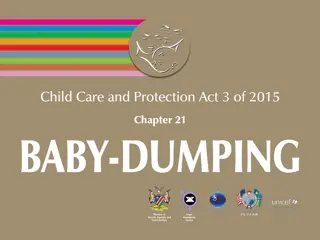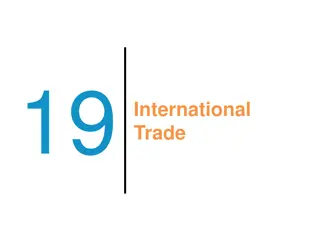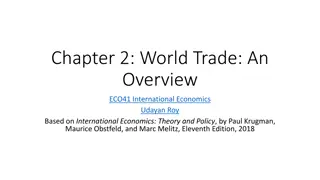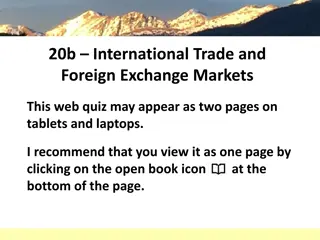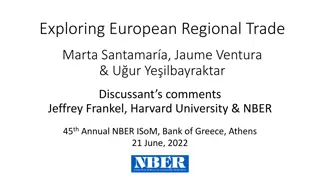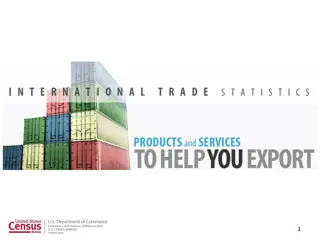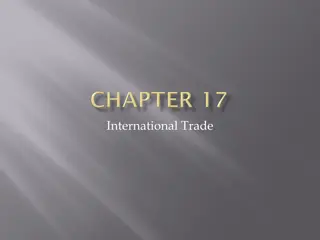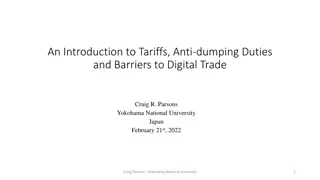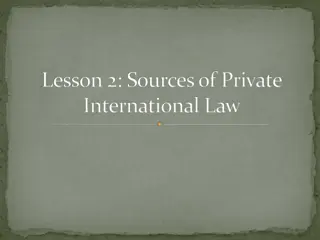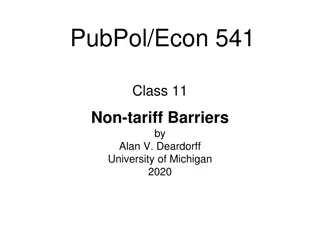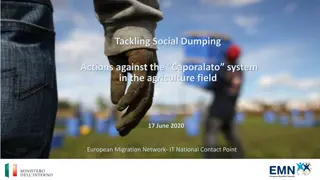Understanding Anti-Dumping Measures in International Trade Law
Exploring the concept of unfair trade practices, particularly focusing on dumping in international trade, including its definition, calculation methods, and anti-dumping policies. The discussion delves into the legal framework provided by the WTO agreements and the implications of dumping on domestic industries.
Download Presentation

Please find below an Image/Link to download the presentation.
The content on the website is provided AS IS for your information and personal use only. It may not be sold, licensed, or shared on other websites without obtaining consent from the author. Download presentation by click this link. If you encounter any issues during the download, it is possible that the publisher has removed the file from their server.
E N D
Presentation Transcript
WTO Law Class 13: TDI Ferrara 2018 Dr. Holger Hestermeyer Shell Reader in International Dispute Resolution, King s College London
Unfair trade, TDI What constitutes unfair trade Cartels, price fixing, abuse of a dominant position etc. A lot of this: not provided for, but: trade defense Idea: level playing field WTO Law Art. VI GATT (anti-dumping, countervailing duties), Art. XVI (subsidies), Art. XIX (emergency action), inadequate: too vague 1967: Kennedy Codes 1979 Tokyo Round Codes Agreement on Implementation of Article VI of the GATT (Anti-Dumping Agreement) Agreement on Subsidies and Countervailing Measures Agreement on Safeguards
Dumping What is Dumping? Type of international price discrimination Compare: price and cost of product in exporting country, price in importing country Art. VI GATT, Art. 2.1 ADA Is it good or bad (price discrimination, cheaper access) Dumping not prohibited (also: it is private action) But: Art. VI GATT: condemned if it causes or threatens material injury to an established industry
Calculating Dumping Definition: Normal value > export price AB: definition of dumping identical in all provisions of the Agreement, for all types of AD proceedings (original investigation, new shipper reviews, periodic reviews) Definition in relations to a product, related to an exporter or foreign producer, must be determined for products as a whole and in respect of each known exporter or foreign producer examined; must be examined in relations to all transactions over a period of time; in cases of targeted dumping to certain purchasers, regions applicable universe of transactions more limited Normal value: Art. 2.1 (like product in home market of the exporter or producer if in the ordinary course of trade of like product destined for consumption in exporting country price comparable) See e.g. 2.2 Export price: based on transaction price at which producer in exporting country sells to importer, see 2.3 Fair comparison: 2.4 Dumping margin: established for each exporter/producer, take into account prices of all export transactions of that exporter, 2.4.2
Anti-Dumping Policies Not mandatory If Member chooses to have them: Art. 1 ADA Before taking anti-dumping measure: investigation according to pre-existing legislation, properly notified to WTO Determination must be made that There is duping Domestic industry producing the like product in the importing country is suffering injury Causal link between dumping and injury -> permissible Anti-dumping measures Provisional measures Price undertakings Definitive anti-dumping measures No other measures (US Offset Act (Byrd Amendment): distribution of duties to affected domestic producers -> not permitted)
Anti-Dumping: Empirics Very common: 2015-2016 31 Members initiated 267 AD investigations; 151 new AD measures 1995 to 2015 most frequent users: India (1); US (2), EU (3) Biggest targets: China (820) Korea (225), Taipei (184)
Subsidies What are subsidies? Basic overview: Some are prohibited Some are actionable (can be challenged, must be withdrawn when causing adverse effects Where subsidy causes / threatens to cause material injury to the domestic industry of other member: authorized to impose countervailing duties to offset subsidization
Subsidies Art. 1.1 SCM Agreement, 1.2 SCM Agreement (only specific subsidies) Subsidies follow different concept from dumping: certain subsidies are prohibited, many other subsidies, where specific, may be challenged when they cause adverse effects Members may respond to subsidised trade which causes injury to the domestic industry producing the like product by imposing countervailing duties to offset subsidy AFTER an investigation establishing Subsidised imports Material injury to domestic industry or threat thereof Causal link
Subsidies - empirics Thousands of subsidies notified 1995-2015: 216 countervailing measures imposed, 410 investigations initiated most frequent users: US (1), EU (2), Canada (3) Most frequent targets: China (1), India (2) Product categories: metals and articles based on them







